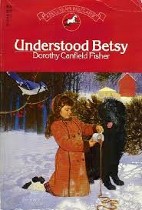 Dorothy Canfield Fisher •
Dorothy Canfield Fisher •
Understood Betsy •
Nine-year-old Elizabeth Ann has been sheltered almost to the point of extinction when a family crisis sends her to live with unknown relatives in Vermont. Over the space of ten months, timid, fearful Elizabeth Ann is transformed into confident, capable Betsy.
There is rural charm aplenty here—horse-and-buggy rides, a county fair, lessons in butter churning, even the proverbial one-room schoolhouse. But the real joy for a reader lies in Fisher’s development of the characters. A simple scene where old Shep begs for scraps at the dinner table tells you everything you need to know about Aunt Abigail, Uncle Henry, and Cousin Ann—not to mention Shep and Betsy. The latter is delighted to find that she understands dog talk.
And by the book’s end, she understands other kinds of language as well. “What people said didn’t matter as much as what they looked.”
Fisher has a disarming habit of breaking down the fourth wall to address the reader directly. “Elizabeth Ann was a very impressionable child. I wonder, by the way, if anybody ever saw a child who wasn’t.” It’s as if she were drawing you into a conspiracy, making you a participant in the book’s events rather than an observer of them.
Elsewhere, a group of little girls are “full of excitement, looking over their shoulders at nothing and pressing their hands over their mouths to keep back the giggles. There was, of course, no earthly reason why they should giggle, which is, of course, the reason why they did. If you’ve ever been a little girl you know about that.”
Then comes the day when Betsy is summoned back to the medium-sized city “probably very much like the place you live in yourself.” What will she do?
Understood Betsy is a classic that never grows old.






Your email address will not be published.